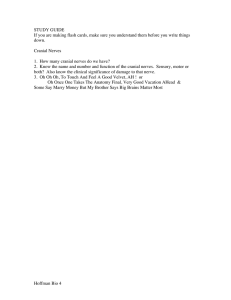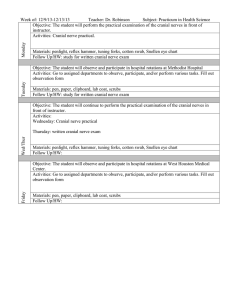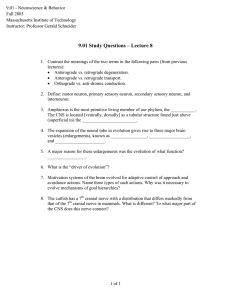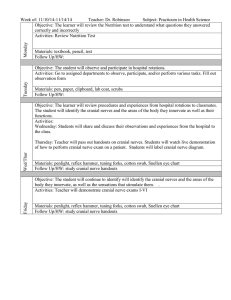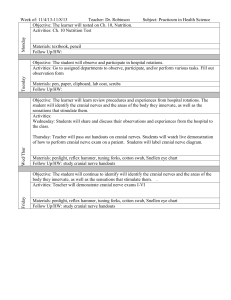cranial nerves1
advertisement
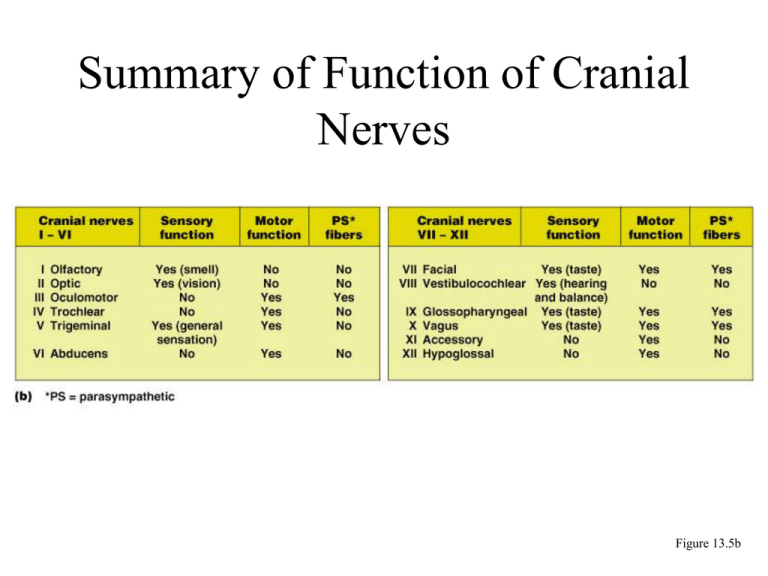
Summary of Function of Cranial Nerves Figure 13.5b Cranial Nerve I: Olfactory • Arises from the olfactory epithelium • Passes through the cribriform plate of the ethmoid bone • Fibers run through the olfactory bulb and terminate in the primary olfactory cortex • Functions solely by carrying afferent impulses for the sense of smell Cranial Nerve I: Olfactory Figure I from Table 13.2 Cranial Nerve II: Optic • Arises from the retina of the eye • Optic nerves pass through the optic canals and converge at the optic chiasm • They continue to the thalamus where they synapse • From there, the optic radiation fibers run to the visual cortex • Functions solely by carrying afferent impulses for vision Cranial Nerve II: Optic Figure II Table 13.2 Cranial Nerve III: Oculomotor • Fibers extend from the ventral midbrain, pass through the superior orbital fissure, and go to the extrinsic eye muscles • Functions in raising the eyelid, directing the eyeball, constricting the iris, and controlling lens shape • The latter 2 functions are parasympathetically controlled • Parasympathetic cell bodies are in the ciliary ganglia Cranial Nerve III: Oculomotor Figure III from Table 13.2 Cranial Nerve IV: Trochlear • Fibers emerge from the dorsal midbrain and enter the orbits via the superior orbital fissures; innervate the superior oblique muscle • Primarily a motor nerve that directs the eyeball Cranial Nerve IV: Trochlear Figure IV from Table 13.2 Cranial Nerve V: Trigeminal • Composed of three divisions – Ophthalmic (V1) – Maxillary (V2) – Mandibular (V3) • Fibers run from the face to the pons via the superior orbital fissure (V1), the foramen rotundum (V2), and the foramen ovale (V3) • Conveys sensory impulses from various areas of the face (V1) and (V2), and supplies motor fibers (V3) for mastication • Tic douloureux or trigeminal neuralgia - Most excruciating pain known (?) - Caused by inflammation of nerve - In severe cases, nerve is cut; relieves agony but results in loss of sensation on that side of the face Cranial Nerve V: Trigeminal Cranial Nerve VI: Abducens • Fibers leave the inferior pons and enter the orbit via the superior orbital fissure • Primarily a motor nerve innervating the lateral rectus muscle (abducts the eye; thus the name abducens) Cranial Nerve VII: Facial • Fibers leave the pons, travel through the internal acoustic meatus, and emerge through the stylomastoid foramen to the lateral aspect of the face • Motor functions include; – Facial expression – Transmittal of parasympathetic impulses to lacrimal and salivary glands (submandibular and sublingual glands) • Sensory function is taste from taste buds of anterior two-thirds of the tongue Cranial Nerve VII: Facial Figure VII from Table 13.2 Facial Nerve (CN VII) • Bell’s palsy: paralysis of facial muscles on affected side and loss of taste sensation • Caused by herpes simplex I virus • Lower eyelid droops • Corner of mouth sags • Tears drip continuously and eye cannot be completely closed (dry eye may occur) • Condition my disappear spontaneously without treatment Cranial Nerve VIII: Vestibulocochlear • Fibers arise from the hearing and equilibrium apparatus of the inner ear, pass through the internal acoustic meatus, and enter the brainstem at the pons-medulla border • Two divisions – cochlear (hearing) and vestibular (balance) • Functions are solely sensory – equilibrium and hearing Cranial Nerve VIII: Vestibulocochlear Figure VIII from Table 13.2 Cranial Nerve IX: Glossopharyngeal • Fibers emerge from the medulla, leave the skull via the jugular foramen, and run to the throat • Nerve IX is a mixed nerve with motor and sensory functions • Motor – innervates part of the tongue and pharynx, and provides motor fibers to the parotid salivary gland • Sensory – fibers conduct taste and general sensory impulses from the tongue and pharynx Cranial Nerve IX: Glossopharyngeal Figure IX from Table 13.2 Cranial Nerve X: Vagus • The only cranial nerve that extends beyond the head and neck • Fibers emerge from the medulla via the jugular foramen • The vagus is a mixed nerve • Most motor fibers are parasympathetic fibers to the heart, lungs, and visceral organs • Its sensory function is in taste • Paralysis leads to hoarseness • Total destruction incompatible with life Cranial Nerve X: Vagus Cranial Nerve XI: Accessory • Formed from a cranial root emerging from the medulla and a spinal root arising from the superior region of the spinal cord • The spinal root passes upward into the cranium via the foramen magnum • The accessory nerve leaves the cranium via the jugular foramen • Primarily a motor nerve – Supplies fibers to the larynx, pharynx, and soft palate – Innervates the trapezius and sternocleidomastoid, which move the head and neck Cranial Nerve XI: Accessory Figure XI from Table 13.2 Cranial Nerve XII: Hypoglossal • Fibers arise from the medulla and exit the skull via the hypoglossal canal • Innervates both extrinsic and intrinsic muscles of the tongue, which contribute to swallowing and speech • If damaged, difficulties in speech and swallowing; inability to protrude tongue Cranial Nerve XII: Hypoglossal
